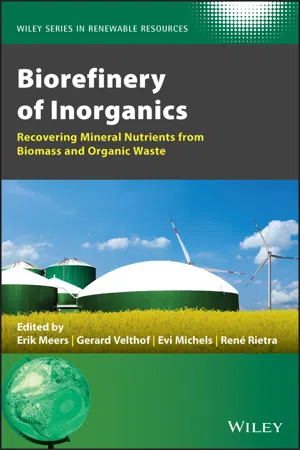
Biorefinery of Inorganics
Recovering Mineral Nutrients from Biomass and Organic Waste
- English
- ePUB (mobile friendly)
- Available on iOS & Android
Biorefinery of Inorganics
Recovering Mineral Nutrients from Biomass and Organic Waste
About This Book
Provides complete coverage of the recovery of mineral nutrients from biomass and organic waste
This book presents a comprehensive overview of the potential for mineral recovery from wastes, addressing technological issues as well as economic, ecological, and agronomic full-scale field assessments. It serves as a complete reference work for experts in the field and provides teaching material for future experts specializing in environmental technology sectors.
Biorefinery of Inorganics: Recovering Mineral Nutrients from Biomass and Organic Waste starts by explaining the concept of using anaerobic digestion as a biorefinery for production of an energy carrier in addition to mineral secondary resources. It then discusses the current state of mineral fertilizer use throughout the world, offering readers a complete look at the resource availability and energy intensity. Technical aspects of mineral recovery organic (waste-)streams is discussed next, followed by an examination of the economics of biobased products and their mineral counterparts. The book also covers the environmental impact assessment of the production and use of bio-based fertilizers; modelling and optimization of nutrient recovery from wastes; and more.
- Discusses global production and consumption of mineral fertilizers
- Introduces technologies for the recovery of mineral NPK from organic wastes and residues
- Covers chemical characterization and speciation of refined secondary resources, and shows readers how to assess biobased mineral resources
- Discusses applications of recovered minerals in the inorganic chemistry sector
- Compares the economics of biobased products with current fossil-based counterparts
- Offers an ecological assessment of introducing biobased products in the current fertilizer industry
- Edited by leading experts in the field
Biorefinery of Inorganics: Recovering Mineral Nutrients from Biomass and Organic Waste is an ideal book for scientists, environmental engineers, and end-users in the agro-industry, the waste industry, water and wastewater treatment, and agriculture. It will also be of great benefit to policy makers and regulators working in these fields.
Frequently asked questions
Information
Section V
Agricultural and Environmental Performance of Biobased Fertilizer Substitutes: Overview of Field Assessments
5.1
Fertilizer Replacement Value: Linking Organic Residues to Mineral Fertilizers
5.1.1 Introduction
Table of contents
- Cover
- Table of Contents
- Wiley SeriesinRenewable Resources
- List of Contributors
- Series Preface
- Preface
- Section I: Global Nutrient Flows and Cycling in Food Systems
- Section II: The Role of Policy Frameworks in the Transition Toward Nutrient Recycling
- Section III : State of the Art and Emerging Technologies in Nutrient Recovery from Organic Residues
- Section IV: Inspiring Cases in Nutrient Recovery Processes
- Section V: Agricultural and Environmental Performance of Biobased Fertilizer Substitutes: Overview of Field Assessments
- Section VI: Economics of Biobased Products and Their Mineral Counterparts
- Section VII: Environmental Impact Assessment on the Production and Use of Biobased Fertilizers
- Section VIII: Modeling and Optimization of Nutrient Recovery from Wastes: Advances and Limitations
- Index
- End User License Agreement